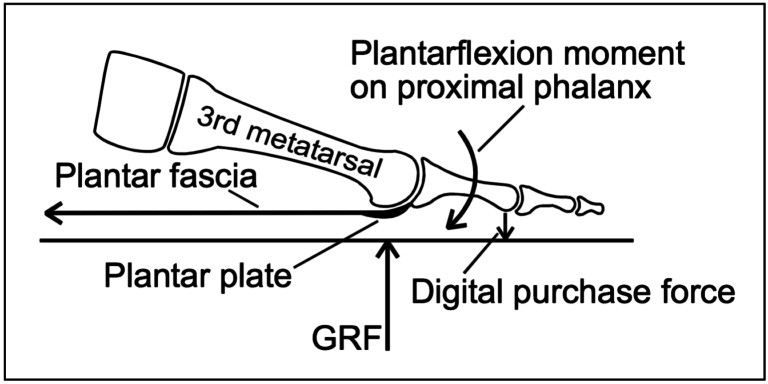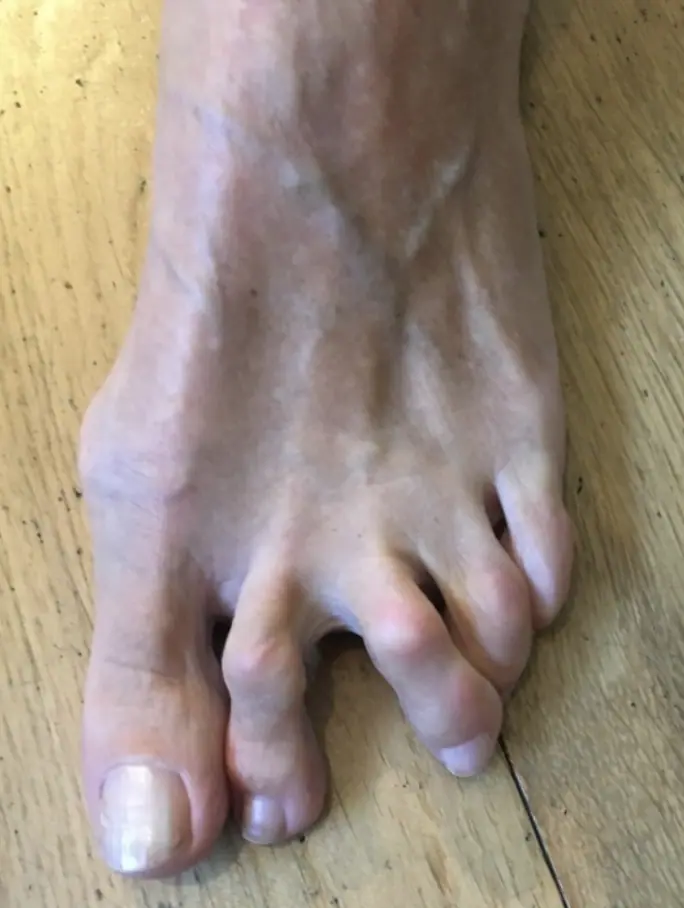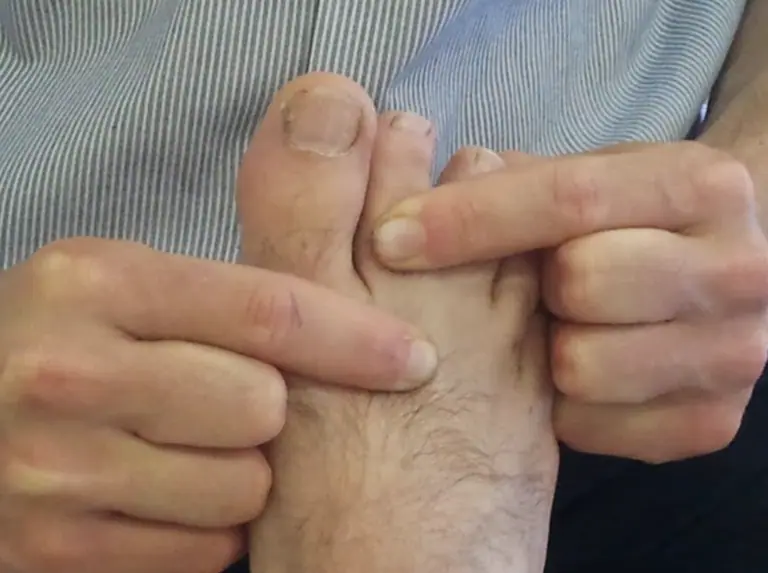Understanding Plantar Plate Tears
What is the Plantar Plate?
The plantar plate is a thick, fibrocartilaginous structure located in the forefoot. It originates from the metatarsal head and attaches to the proximal phalanx via the joint capsule. Its primary function is to stabilize the metatarsophalangeal joints (MTPJ) and facilitate the reverse windlass mechanism, which involves the plantar fascia and helps with toe flexion during foot loading. At Cheltenham Podiatry we commonly see these injuries, either are due to increase loading and degeneration with age, or from high loading in high level soccer players and dance professionals. If left untreated, toe deformity, and arthritis can develop.

Diagnosis Challenges
Plantar plate injuries are often underdiagnosed, partly due to a lack of awareness. These injuries are sometimes miscategorized under the broad term “metatarsalgia,” which merely describes pain in the ball of the foot rather than pinpointing a specific issue.
Causes of Plantar Plate Injuries
- Repetitive Activities: Excessive dorsiflexion from activities like running and jumping can strain the plantar plate. Common in soccer and dance.
- Biomechanical Factors: Conditions like hallux valgus, irregular metatarsal lengths, tight calf and external factors such as wearing high heels can increase load on the plantar plate. Poor biomechanical functioning.
- Chronic Overuse: These injuries are often due to chronic overuse rather than a single traumatic event.
Clinical Presentation
Patients typically present with:
- Pain around the MTPJ, both/either dorsally(top foot) and plantarly(bottom foot)
- Thong like presentation- toes spread apart
- Mild edema, possibly following an episode of trauma
- Increased pain with weight-bearing activities and certain types of footwear
- Reduced plantar flexion strength
- Positive findings on tests like the Digital Lachman’s (Anterior Draw) or Vertical Stress Test


Diagnostic Tests
- Footstool Edge Test: Assesses the reverse windlass mechanism by checking if the proximal phalanges flex when standing on the edge of a stool.
- Digital Lachman’s/Vertical Stress Test: Evaluates the integrity of the plantar plate by applying a vertical force to the toe and looking for pain and translocation.
- Imaging: MRI and ultrasound are commonly used, with MRI showing higher sensitivity. Ultrasound is very accurate in diagnosis in the hands of a good sonographer. X-rays can help rule out other bony pathologies if suspected.
Grading Systems
Two main grading systems are used for assessing plantar plate injuries:
- Thompson and Hamilton: Focuses on the degree of dorsal translocation of the proximal phalanx.
- Yu and Judge: Describes clinical findings and stages based on edema and anatomical alignment.
Treatment Approaches
Plantar plate tear, particularly a full tear can be difficult to heal, where as partial tear has better prospects. Age, health, and other factors can influence healing. It can take usually 8-12 weeks or more.
Effective management focuses on reducing load on the plantar plate and addressing contributing factors:
- Activity Modification: Avoid barefoot walking and activities that exacerbate symptoms.
- Footwear: Use stiff-soled shoes and avoid high heels or flexible footwear.
- Stretching and Strengthening: Address tight calf muscles and strengthen foot muscles, particularly toe flexors to improve mechanics and strength .
- Strapping: Use rigid tape to maintain the toe in a plantar flexed position.
- Orthoses or Carbon plates: Foot padding maybe incorporated.
- Platelet Rich Plasma Injections: Can be effective to speed healing.

Conservative Management
A conservative treatment plan may include:
- Avoiding barefoot walking for at least six weeks
- Wearing stiff-soled shoes
- Regular strapping of the affected digit
- Modifying activities to reduce stress on the plantar plate
- Using orthoses/plate to offload the MTPJ
- Implementing a stretching and strengthening regimen
Innovative Treatments
- Photobiomodulation (PBM)
Photobiomodulation, also known as low-level laser therapy (LLLT), uses light therapy to reduce pain and inflammation and promote healing. This non-invasive treatment can be particularly beneficial for plantar plate injuries by enhancing cellular repair and reducing edema.
- How It Works: PBM involves using specific wavelengths of light to penetrate tissues, stimulating cellular energy production and reducing oxidative stress.
- Benefits: Non-invasive, painless, and can be combined with other treatments to enhance healing.
- Ultrasound-Guided Platelet-Rich Plasma (PRP) Injection
PRP therapy involves injecting highly concentrated platelets ( often 5 billion) from the patient’s own blood into the injury site to promote healing. When guided by ultrasound, the injection can be precisely delivered to the damaged plantar plate.
- How It Works: PRP contains growth factors that accelerate tissue repair and regeneration. The ultrasound guidance ensures the injection targets the exact injury location.
- Benefits: Minimally invasive, promotes natural healing, and can reduce recovery time.
Integrating New Treatments with Traditional Approaches
Combining traditional treatments with innovative therapies can offer comprehensive management of plantar plate injuries. Here’s a suggested treatment plan that our podiatrists follow, but this may vary according to individual requirements :
- Initial Phase (Weeks 1-6)
- Avoid barefoot walking and high-impact activities.
- Wear stiff-soled shoes/ or carbon plate to reduce stress on the plantar plate.
- Apply strapping to maintain toe position.
- Consider 2-3 platelet rich plasma injection 1-2 weeks apart
- Start photobiomodulation sessions to reduce pain and inflammation.
- After final injection, start rehabilitation program.
- Mid Phase (Weeks 6-12)
- Continue using appropriate footwear, strapping as needed.
- Continue appropriate stretching and strengthening regimen, to strengthen local tissues and improve foot mechanics.
- Where appropriate orthotics can be introduced and slow return to activities.
- Long-Term Phase (Post 12 Weeks)
- Gradually reintroduce full level activities while monitoring symptoms.
- Continue to strengthen local tissues, and appropriate rehabilitation.
- Use orthoses to provide ongoing support and offload the plantar plate.
- Maintain regular PBM sessions if needed to manage residual pain and support healing if still required.
Regular reviews are essential, and often regular ultrasound assessment to ensure appropriate staging and healing of the plantar plate, surgical intervention might be necessary where it fails to heal.
Conclusion
Early and accurate diagnosis, combined with appropriate treatment, can effectively manage plantar plate injuries and prevent complications like toe deformities, and arthritis . Cheltenham Podiatrists are experts in this area, and regularly attend to these injuries in both high performance athletes, weekend warriors and the general population. We have onsite high end ultrasound to help diagnose and provide accurate regenerative injections where required. If you are concerned you may have this condition, our foot and ankle experts are here to help , please book online at now or phone to make a time for assessment.
Latest News
Ankle Arthritis
Understanding Ankle Arthritis and Regenerative Treatment Options in Podiatry Ankle[…]




